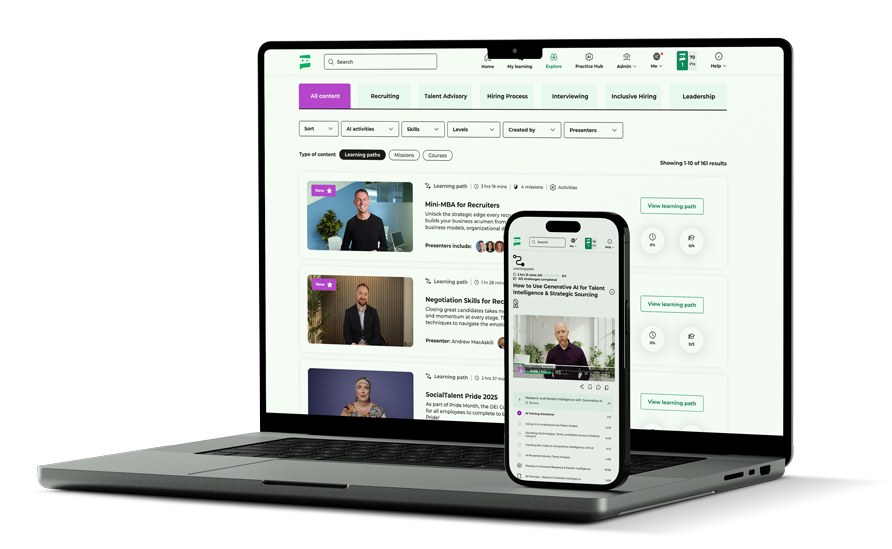Talent News Round-Up: Big Four Entry Level Jobs, Inventory, and Stakeholder-Centric Metrics
Staying updated on the latest workforce trends is crucial for TA leaders and HR professionals. This week, we delve into three significant developments shaping the talent landscape and get SocialTalent’s CEO, Johnny Campbell’s first-hand takes on these pieces.
People Matters: The Big Four are slashing graduate roles as AI and offshoring reshape entry-level hiring, flattening the traditional talent pipeline into a “diamond model.”
Matt Charney: Recruiting has become a supply chain function – candidates treated as inventory, optimized for speed and scale rather than relationships.
Will Ducey: The HERO Index offers a fresh take on recruiting metrics – balancing the needs of all stakeholders to drive strategic, system-level impact.
Join us as we explore these pivotal insights and their implications for the future of work.
1. Big Four Cut Entry-Level Jobs Amid AI and Cost Pressures
Source: People Matters
AI disruption and economic pressures are forcing the Big Four – Deloitte, EY, PwC, and KPMG – to slash entry-level hiring and offshore junior roles. Graduate job postings have plummeted 44%, as smart software takes over high-cognition tasks once reserved for analysts. The traditional talent pyramid is flattening into a “diamond model,” while private equity–backed, tech-savvy firms gain ground. For HR leaders, it’s a wake-up call to rethink early-career development, AI fluency, and global talent strategy.
Johnny Campbell’s take on this:
“These numbers are probably only the beginning; I expect we will see similar trends in software development, sales, customer service and other professions where a combination of AI efficiency and offshoring displaces roles, particularly graduate roles. The days of there being a string of jobs available for graduates are probably over. Welcome back to the 90s folks!“
2. You’re Not Talent. You’re Inventory.
Source: Matt Charney
Recruiting has evolved from a relationship-driven HR function to a data-led supply chain operation. Candidates are now treated as inventory, managed through pipelines, optimized for speed and cost, and filtered by AI. Recruiters function more like demand planners, using KPIs that mirror logistics, not people-first metrics. This shift – driven by automation, finance-led planning, and efficiency mandates – reflects a systemic change: hiring isn’t about relationships anymore. It’s about throughput, scalability, and fulfilling workforce demand.
Johnny Campbell’s take on this:
“I love Matt and his Snark Attack and as usual, there’s a lot of truth in this article but there’s also nuance that I think he is deliberately leaving out. I like the supply chain analogy but small producers still hand pick their suppliers and even large scale producers still focus on quality from their volume suppliers. The truth is that there is always a balance of quality and efficiency in hiring; it’s just more evident now. Is that a bad thing? Hell no, it offers tons of opportunity for differentiated hiring strategies as unlike supply chain logistics, this “commodity” has a very limited supply and more importantly, it has its own mind!“
3. Rethinking Recruiting Metrics: A Stakeholder-Centric Approach
Source: Will Ducey
Recruiting is a system and optimizing for one stakeholder alone weakens the whole. In this stakeholder-centric rethink, Will Ducey introduces the HERO Index: a unified recruiting framework balancing metrics for recruiters, hiring managers, candidates, and the business. By aligning goals and tracking efficiency, outcomes, and impact, recruiting teams can elevate strategic conversations, escape reactive reporting, and deliver consistent value – regardless of hiring climate. It’s a shift from chasing metrics to owning the narrative.
Johnny Campbell’s take on this:
“Recruiting metrics are hotly debated. Everyone has their own version of what they measure and what we should all focus on and Will is no different. Or is he?
I actually think this is a really well thought out way to think about stakeholder metrics, all plugged into one magic number. Do I agree with him on all the KPI’s? Hell no (see sentence 2). But I absolutely think he is directionally on to something. Check it out and let me know if you agree!“




